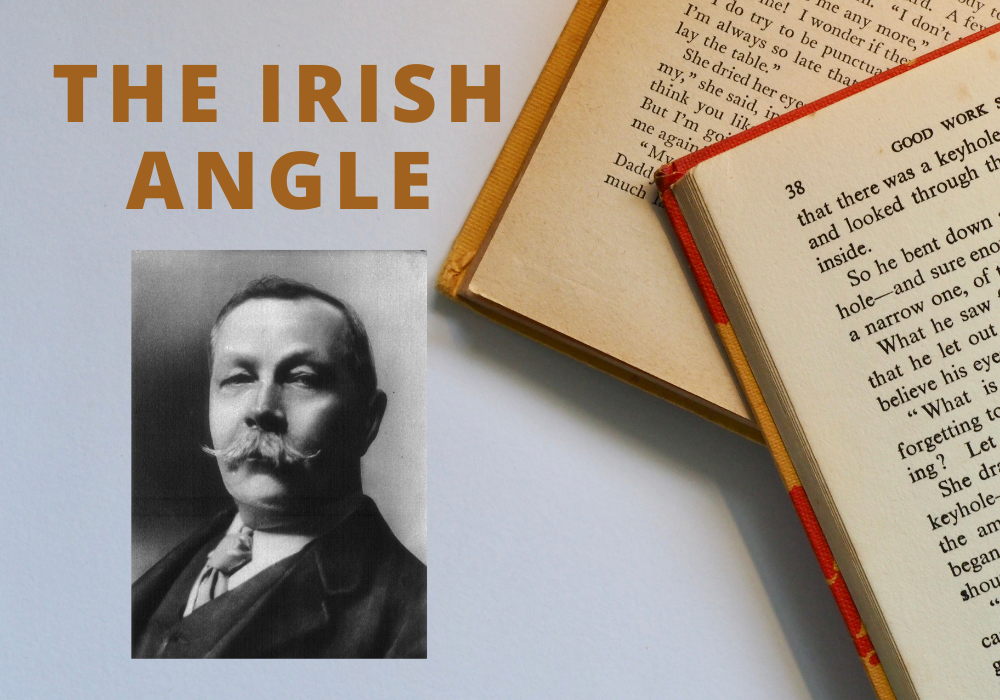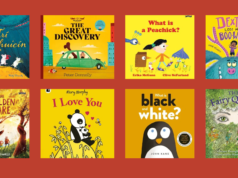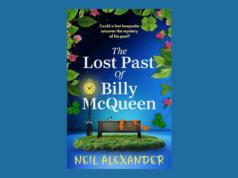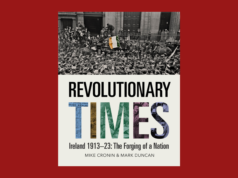Arthur Conan Doyle’s The Valley of Fear—Irish-American terror comes to rural England.

THE IRISH ANGLE
Arthur Conan Doyle’s own Irish connections are well documented. His father, Charles Altamont Doyle, was born in England of Irish Catholic descent, and his mother, Mary (née Foley), was an Irish Catholic (see Andrew Lycett, Books Ireland, March/April 2015). Doyle visited Ireland on a number of occasions—he spent his honeymoon there—and took an interest in Irish affairs. He had little sympathy for Irish nationalism, however. It is said that an encounter with Fenians when he was seven years old and holidaying with relatives in King’s County (Offaly) coloured his view of militant nationalism. Later, in 1881 he stayed with relatives in Wexford, reporting that the country was disturbed with cattle maiming, attacks on bailiffs and other outrages—another experience that turned him against extremism.
Given his Irish connections, it is not surprising that Ireland features in some of his writing. Edward Malone is a key character in The Lost World, and the Sherlock Holmes story, The Adventure of the Crooked Man, features an Irish regiment in the British Army, the Royal Mallows, but their being Irish is incidental to the main plot. Sherlock Holmes’ nemesis, Professor Moriarty, has an Irish surname and is said to have been inspired by Prof. George Boole, first professor of Mathematics at Queen’s College Cork, or even the prominent Fenian John O’Connor Power, although Doyle does not specifically identify him as Irish.
Irish characters, however, feature large in the Sherlock Holmes adventure The Valley of Fear. Set in the 1890s, the case begins when a minion of Moriarty’s informs Holmes of a planned murder. Holmes and Watson arrive at a remote mansion in the English countryside too late to stop the crime, but the famous detective is intent on catching the killer. The first indication of an Irish connection is the information that the victim, John Douglas, originally came from Ireland. It emerges that Douglas made his fortune in the United States and that he has a dark secret in his past. The novel is in two parts: the first concerns the murder and the killer’s capture, the second gives the backstory of why the crime happened. In it the reader is transported to the 1870s and the Vermissa Valley in America, centre of the coal mining industry, which is terrorised by a secret organisation known as the Scowrers, referred to as ‘the boys’, a common euphemism for secret organisations in Ireland to this day. Writing to his publisher, Doyle claimed, ‘I make it vague and international with nothing to offend anyone’, but it is clear that the Scowrers are predominantly Irish in origin and that the brutal and bloodthirsty character of the organisation is a reflection of its Irish influence. They operate under cover of a pseudo-masonic society, the Ancient Order of Freemen (i.e. the Ancient Order of Hibernians) but they have subverted the benevolent intentions of the Order for their own ends.
The hero of the story, John McMurdo, comes from County Monaghan by way of Chicago. While McMurdo is a convincing hero, Doyle resorts to cliché in conveying his Irish character. He addresses his love as ‘acushla’ (from the Irish cuisle, meaning a heartbeat) and it is said that he possesses a ‘glib Irish tongue’. Other Irish characteristics are conveyed in phrases like ‘hot Irish blood’ and ‘dancing Irish devilry in [his] eyes’. The villain of the piece is Bodymaster McGinty, the leader of the Scowrers, who is described in simian terms, a common trope of anti-Irish racism in nineteenth-century Britain. Much of the story is taken up with a chronicle of the bloody deeds of the Scowrers, who are finally brought to justice by an undercover Pinkerton agent, whose life is forfeit as a result.
The Scowrers of the novel are clearly inspired by the real-life Molly Maguires. The Molly Maguires originated as a secret society in nineteenth-century Ireland and is said to have travelled with Irish emigrants to Liverpool and parts of the eastern United States. They are best known for their campaign on behalf of Irish-American and Irish-immigrant coal miners in Pennsylvania. After a series of violent conflicts between the Mollies and the mine companies, twenty suspected members were convicted of murder, arson, kidnapping and other crimes, and were executed by hanging in 1877 and 1878. The violence was not simply one-way, however, as the coal mining companies, as well as having their own armed police force, hired vigilantes who ambushed and murdered miners suspected of being Molly Maguires, as well as their families.
Historians sympathetic to the Molly Maguires point out that violence was only resorted to because peaceful union activity was brutally suppressed by the mine owners and that the Mollies were motivated by class issues rather than simply being criminals. (Others question the very existence of such an organisation.) What is not disputed is that the miners worked under dangerous and health-destroying conditions for very low wages. In The Valley of Fear, Doyle makes it clear that Boss McGinty has become rich through his control of the Scowrers and that local companies are forced to pay protection money to him. On the other hand, other members of the organisation are portrayed as being motivated by injustice and see themselves as waging a class war against ‘the capitalists’. It may be just coincidence that The Valley of Fear was serialised in 1914 when the Government of Ireland Act, granting Irish Home Rule, was passing through the British Parliament. The question of whether the Irish were fit to govern themselves was to the fore and informed readers of The Valley of Fear could not fail to see the relevance of its portrayal of the Irish as violently criminal.
***
Tony Canavan,
Consultant Editor, Books Ireland











